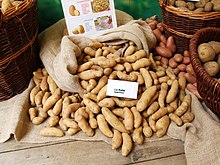
French fries, chips, finger chips, french-fried potatoes, or simply fries are batonnet or allumette-cut deep-fried potatoes of disputed origin from Belgium or France. They are prepared by cutting potatoes into even strips, drying them, and frying them, usually in a deep fryer. Pre-cut, blanched, and frozen russet potatoes are widely used, and sometimes baked in a regular or convection oven; air fryers are small convection ovens marketed for frying potatoes.
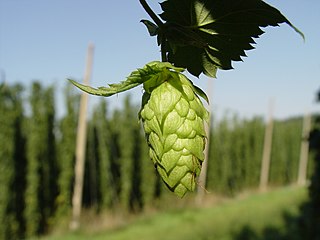
Hops are the flowers of the hop plant Humulus lupulus, a member of the Cannabaceae family of flowering plants. They are used primarily as a bittering, flavouring, and stability agent in beer, to which, in addition to bitterness, they impart floral, fruity, or citrus flavours and aromas. Hops are also used for various purposes in other beverages and herbal medicine. The hops plants have separate female and male plants, and only female plants are used for commercial production. The hop plant is a vigorous, climbing, herbaceous perennial, usually trained to grow up strings in a field called a hopfield, hop garden, or hop yard when grown commercially. Many different varieties of hops are grown by farmers around the world, with different types used for particular styles of beer.

A potato chip or crisp is a thin slice of potato that has been deep fried, baked, or air fried until crunchy. They are commonly served as a snack, side dish, or appetizer. The basic chips are cooked and salted; additional varieties are manufactured using various flavorings and ingredients including herbs, spices, cheeses, other natural flavors, artificial flavors, and additives.
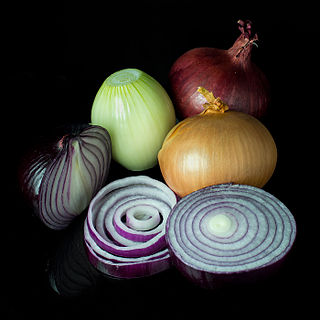
An onion, also known as the bulb onion or common onion, is a vegetable that is the most widely cultivated species of the genus Allium. The shallot is a botanical variety of the onion which was classified as a separate species until 2011. Its close relatives include garlic, scallion, leek, and chive.

The radish is an edible root vegetable of the mustard family, Brassicaceae, that was domesticated in Asia prior to Roman times.

The zucchini, courgette or baby marrow is a summer squash, a vining herbaceous plant whose fruit are harvested when their immature seeds and epicarp (rind) are still soft and edible. It is closely related, but not identical, to the marrow; its fruit may be called marrow when mature.

Lithuanian cuisine features products suited to the cool and moist northern climate of Lithuania: barley, potatoes, rye, beets, greens, berries, and mushrooms are locally grown, and dairy products are one of its specialties. Various ways of pickling were used to preserve food for winter. Soups are extremely popular, and are widely regarded as the key to good health. Since it shares its climate and agricultural practices with Northern Europe, Lithuanian cuisine has much in common with its Baltic neighbors and, in general, northern countries.
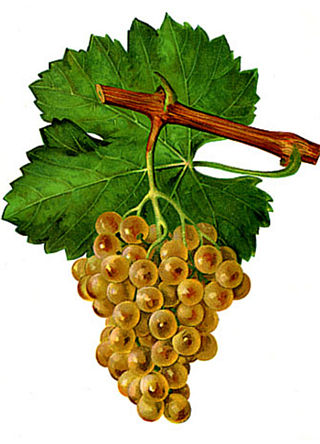
Sémillon is a golden-skinned grape used to make dry and sweet white wines, mostly in France and Australia. Its thin skin and susceptibility to botrytis make it dominate the sweet wine region Sauternes AOC and Barsac AOC.

Hōjicha is a Japanese green tea. It is distinctive from other Japanese green teas because it is roasted in a porcelain pot over charcoal. It is roasted at 150 °C (302 °F) to prevent oxidation and produce a light golden colour, as opposed to other Japanese teas which are steamed. In general, the base of a hōjicha consists of leaves from the second harvest or after.
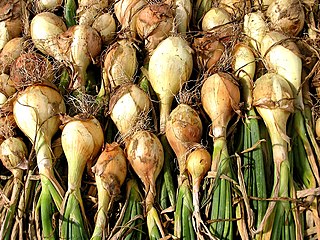
White onion or Allium cepa are a cultivar of dry onion which have a distinct light and mild flavour profile. Much like red onions, they have a high sugar and low sulphur content, and thus have a relatively short shelf life. White onions are used in a variety of dishes, such as those of Mexican and European origin. Their uses in dishes often relate to their mild nature, they are often included in dishes to provide a light, fresh and sour taste to dishes and are often added uncooked to dishes such as salads.
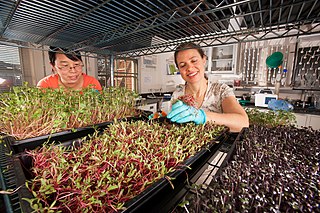
Microgreens are vegetable greens harvested just after the cotyledon leaves have developed with one set of true leaves. They are used as a visual, flavor and texture enhancement. Microgreens are used to add sweetness and spiciness to foods. Microgreens are smaller than "baby greens" because they are harvested soon after sprouting, rather than after the plant has matured to produce multiple leaves.

'Vitelotte', also called Vitelotte noire, Négresse or Truffe de Chine, is a gourmet French variety of blue-violet potato. It has been cultivated in France at least since the early nineteenth century.

The tomato is the edible berry of the plant Solanum lycopersicum, commonly known as the tomato plant. The species originated in western South America, Mexico, and Central America. The Nahuatl word tomatl gave rise to the Spanish word tomate, from which the English word tomato derives. Its domestication and use as a cultivated food may have originated with the indigenous peoples of Mexico. The Aztecs used tomatoes in their cooking at the time of the Spanish conquest of the Aztec Empire, and after the Spanish encountered the tomato for the first time after their contact with the Aztecs, they brought the plant to Europe, in a widespread transfer of plants known as the Columbian exchange. From there, the tomato was introduced to other parts of the European-colonized world during the 16th century.
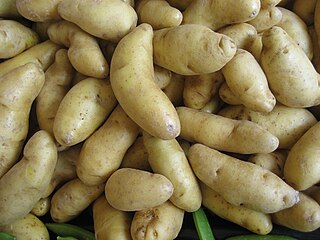
A fingerling potato is a small, stubby, finger-shaped type of potato which may be any heritage potato cultivars. Fingerlings are varieties that naturally grow small and narrow. They are fully mature when harvested and are not to be confused with new potatoes. Popular fingerling potatoes include the yellow-skinned Russian Banana, the pink-skinned, yellow fleshed French Fingerling, the Purple Peruvian, and the Swedish Peanut Fingerling. Due to their size and greater expense compared to other potatoes, fingerlings are commonly either halved and roasted as a side dish or used in salads.

Known as The Garden of Wales, Carmarthenshire is a county of rich, fertile farmland and productive seas and estuaries, that give it a range of foods that motivate many home cooks and restaurateurs. There is a local tradition in brewing, milling, gathering shellfish from the coasts and meat production. Carmarthenshire has been described by The Daily Telegraph as a "worthwhile destination for foodies" with the county having a modest matter of fact excellence. Carmarthenshire has ambitions to become the premier food-producing county of Wales, based on its strong reputation for first-class products. and Carmarthenshire County Council produces its own on-line and hard-copy recipe book called Taste from Carmarthenshire, for those interested in learning more about the county's cuisine.
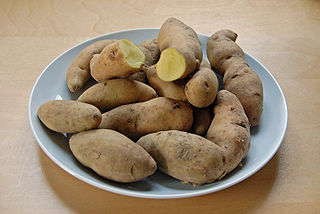
The Bamberg potato is an old potato variety from Franconia. It takes its name from the town of Bamberg.

The Celebrity tomato cultivar is a hybrid (biology) that produces long fruit-bearing stems holding 20 or more very plump, robust tomatoes. Fruits weigh approximately 8 oz., and are 4 inches across. Plants need caging or staking, and produce fruit throughout the growing season. The celebrity tomato is a cultivar of the species Solanum lycopersicum. It is a crossbreed of the common tomato that is widely used for various culinary purposes. This tomato is of great size and is known to be resistant to most tomato diseases such as Fusarium wilt, Verticillium wilt, Tobacco mosaic virus and Root-knot nematode due to its hybrid nature. Celebrity tomatoes are highly adaptive to harsh environments and can grow in a wide range of places including dry, humid and wet regions. They are resistant to cracking and splitting which usually occurs when there is an excess of water and sugar movement in the fruits. Therefore, causing the tomato skin to grow at a slower rate compared to the expansion of the fruit. They can survive in harsh uneven rainfall. However, they are highly susceptible to colder environments and are at a higher risk of dying in regions with short growing seasons. The plants can grow up to 5 feet in height with bright red medium-sized fruits. The plants are generally very thick and grow in clusters. The tomato fruits are mostly used in the making of various salsas, salads, juices and canned food.

Triple-cooked chips are a type of chips developed by the English chef Heston Blumenthal. Blumenthal began work on the recipe in 1993, and eventually developed the three-stage cooking process. The chips are first simmered, then cooled and drained using a sous-vide technique or by freezing; deep fried at 130 °C (266 °F) and cooled again; and finally deep-fried again at 180 °C (356 °F). The result is what Blumenthal calls "chips with a glass-like crust and a soft, fluffy centre".

Golden Russet is an old American cultivar of domesticated apple which is excellent for fresh eating as well as for apple cider production. It is a russet apple and is therefore especially used as a cider apple. It is sometimes known as 'English Golden Russet', and has frequently been confused with 'English Russet'.
